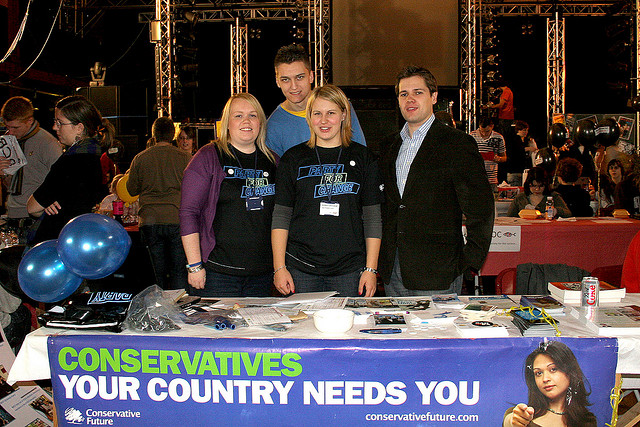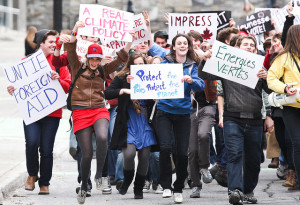Political parties need to better integrate young members and give them the chance to influence policy
Most major political parties have youth wings, run by their young members. But with party membership declining, Emily Rainsford has considered how parties might better engage their young members and recruit others. In this post, part of our new series on youth participation, she argues for more integration of young party members into decision-making structures.

Young activists in the Conservative Party seek to recruit new members. Credit: altogetherfool, CC BY SA 2.0
It should be not considered revelatory news that traditional political parties in Western Europe are struggling to attract members, particularly younger citizens. It is difficult to retrieve reliable figures on political party membership due to complexities of membership eligibility, lack of reliable registers, and evidence of over-reporting in general population surveys. However the overall trend over time is clearly downwards and the proportion of young members joining political parties has declined significantly over time.
At the same time two other trends can be identified in the political landscape that has affected the ways that citizens engage politically. The first observable trend is that political parties have changed in many western societies from being mass membership parties to becoming ‘catch-all’ parties that seek to attract people with more diverse viewpoints and thus appeal to more of the electorate. This has encouraged a political culture in many states whereby parties have become more organisationally elitist and ideologically homogenous. As a consequence the role and function of the member has changed. Political parties now rely less on their members for running the party and winning elections, and more on opinion polls, centralised organisations and the employment of political ‘professionals’.
The second trend is that although many citizens have disengaged from formal politics, they have not ceased to behave politically. Rather, scholars have argued that citizens now more readily engage with ‘non-institutionalised’ political groups and activism, such as supporting charities or attending protests. It has been argued that young people are especially attracted to such alternative forms of political activism because they are more interested in doing politics.
Young people and political parties
Regardless of such shifts in the patterns and functions of political participation, the relationship between young people and political parties is a complicated one. Historically, British political parties have rarely attempted to engage with young people or consider issues of youth citizenship or political participation. Conversely, research suggests that young people have increasingly viewed political parties as remote, infantile and divisive in their approach to public debate and policy formulation, and embarrassing in their occasional attempts to appeal to younger. Furthermore, young people have proven most likely to complain that their interests are overlooked by political parties both in terms of policy-formation and electoral campaigning. This has led to a significant disconnection between young people and political parties evidenced through low levels of party identification and composite reluctance to join, donate to, work for, or campaign for them across the UK.
Most main political parties have established youth wings with the express intention to attract younger members, some of whom might be intimidated by joining the main organisation. As the age profile of members of political parties has grown increasingly older, youth wings have been recognised as possessing the potential to address the under-recruitment of young people. This noted,youth wings and young members are typically separated from the main party, meaning relationships with the parent party are conditional and contested.
Youth wings have some independence from the main party to develop their own positions on policy and organise events such as annual conferences. However they are dependent on the main party for funding and their representation and influence is determined by the main party. While some youth wings have seats on the main party executive and/or have some input in policy formation, others do not. As such, scholars have classified them as semi-independent (Lamb, 2002) – at the margins of the main party membership who see the primary function of young wings as recruiting, training, and socialising new members and future leaders.
The segregation and peripheralisation of young people in political parties is evident both in terms of membership and their role in developing policy. There is no agreement between political parties regarding the lower and upper ages that defines ‘youth’ membership, thus reflecting wider uncertainties as to distinctions between youthhood and adulthood. Youth membership for most parties typically falls between an age-range of 15 and 30 years-old, thus excluding younger citizens and extending youth status well beyond most legal definitions of the age of responsibility. If someone within the age threshold defined for youth membership seeks to join the main party, they automatically become members of the youth organisation. At first glance, this might suggest a close relationship between the two organisations in terms of common recruitment and membership bases. However, it is clear that young members of political parties are treated differently to their older counterparts whose membership is not codified or defined in age-specific terms.
Moreover, while many parties have made concerted efforts to include young people in the formation of policy, their marginalisation is still evident. Political parties remain reluctant to give young members too great a voice in party affairs, concerned that potentially radical policy proposals could alienate older voters (who are seen as more likely to vote). Young members are thus mainly consulted on youth issues rather than mainstream ‘adult’ policy that might also affect young people.
New approaches to youth political party membership
It is clear that there are tensions within political parties over how they relate to their young members and the way that young members want to do politics. The membership of young people in political parties should be seen as positive both in terms of providing opportunities to encourage active life-long forms of citizenship and also strengthening democracy by making their voices heard. However there is urgent need for a review of the terms of party membership offered to young people, particularly regarding opportunities within political parties offered to younger members, and the organisational relationships between youth wings and the main parties.
Although the role of youth wings as recruitment agents is important, political parties should recognise this is not their primary or sole function. Recent research suggests that youth wings are not particularly good at recruiting new members, as the majority of the active youth members are not trained or allocated such roles and thus to a large extent fail to do so. Moreover, the premise that youth wings should train young members for roles within the main party potentially drains the youth factions of good leaders and leadership. It also places them in an unfair position in relation to other ‘full’ members of the party as the segregation of young members from the main party structures means that they have limited political experience and skills.
Developing good leaders and leadership through the synchronisation of youth and mainstream wings of political parties are not enough though. There is an urgent need to ensure young members have the means to run youth wings effectively and gain appropriate experience. Therefore the youth wings need to have their own budgets and exercise full control over the allocation of the money. This would strengthen their independence and enable the development of a stronger voice in the political party. It is also vital that youth wings are given the opportunity to extend their influence beyond youth-focused policy issues and are able to shape party policy more widely. The systemic ‘youth-proofing’ of party policy would be a positive step towards integrating younger members more deeply into political parties, thus reducing practices of policy segregation. For example, youth wings should be involved in the development of the 2015 general election manifestos to ensure that they reflect the interests of their young members and young people more widely.
The structural reform of political parties with regards to youth wings is not sufficient on its own to reform how young people engage with political parties. As noted earlier, young people in particular are attracted to single-issue politics and this suggests they are keen to do politics differently. However, the political parties are not equipped to accommodate such changes in political behaviour. When a young person joins a political party they often have an issue in mind that they want to engage with and work on. Current approaches limit the potential for young people to develop single issues within political parties as membership is more typically framed by attending constituency meetings or party election campaigning. As Bennie and Russell note, the ‘rather exclusive and arcane atmosphere that often dominate local meetings’ reflects a ‘familiarity with party regulation’ that acts as barriers to effective youth participation. As such, it is understandable that many young people are not attracted by party politics or excited by the prospect that they can change things through traditional forms of engagement.
Political parties clearly need to integrate young new members better and give them the opportunities to work on issues that motivated them to first join their respective parties. As such they need to take back campaigns from single-issue groups and focus on engaging young people in their own communities. This type of engagement is of particular importance when appealing to those young people who are too young to vote. Engagement with political parties on youth-defined issues could prove a powerful way of allowing young members to interact with the formal policy-making process. By giving young people the opportunity to work on issues that concern them, political parties can become relevant again and would emphasise the importance of active membership within a party. Moreover, political parties can contribute directly to the development of political skills and literacy through the promotion of a political culture that reaches out and seeks to include young people in shaping youth-centric policy.
—
This post is part of a series on youth participation based on the Political Studies Association project, Beyond the Youth Citizenship Commission. For further details, please contact Dr Andy Mycock. An electronic copy of the final report can be downloaded here.
Note: This post represents the views of the author and does not give the position of Democratic Audit or the LSE. Please read our comments policy before responding.
—
Emily Rainsford is a postgraduate research student at the University of Southampton.
is a postgraduate research student at the University of Southampton.






 Democratic Audit's core funding is provided by the Joseph Rowntree Charitable Trust. Additional funding is provided by the London School of Economics.
Democratic Audit's core funding is provided by the Joseph Rowntree Charitable Trust. Additional funding is provided by the London School of Economics.
I wrote a blog!Have a read of what I think political parties need to do for young people.@sotonpolitics @PSAyoungpol https://t.co/v2pHn9xr6D
political parties need to better integrate young members to influence policy https://t.co/ta96UB1F8q @bycLIVE @UKYP @NIYF @OfficialSYP
political parties need to better integrate young members to influence policy https://t.co/ta96UB1F8q @ConHome @Conservatives @LibDems
political parties need to better integrate young members to influence policy https://t.co/ta96UB1F8q @ChloeSmithMP @SadiqKhan
political parties need to better integrate young members to influence policy https://t.co/ta96UB1F8q @UKLabour @LabourList @ProgressOnline
political parties need to better integrate young members to influence policy https://t.co/ta96UB1F8q @BiteTheBallot @HansardSociety @IPPR
@ConsFuture @EmilyRainsford argues political parties need to better integrate young members to influence policy https://t.co/ta96UB1F8q
@EmilyRainsford argues political parties need to better integrate young members to influence policy https://t.co/ta96UB1F8q @LiberalYouth
@EmilyRainsford argues political parties need to better integrate young members to influence policy https://t.co/ta96UB1F8q @YoungLabourUK
Political parties need to better integrate young members and give them the chance to influence policy https://t.co/gWjfe2nuiW
RT @LYLibertine: Food for thought…https://t.co/0RGFpDtupW
Political parties need to better integrate young members and give them the chance to influence policy https://t.co/NgUnwcaXfA